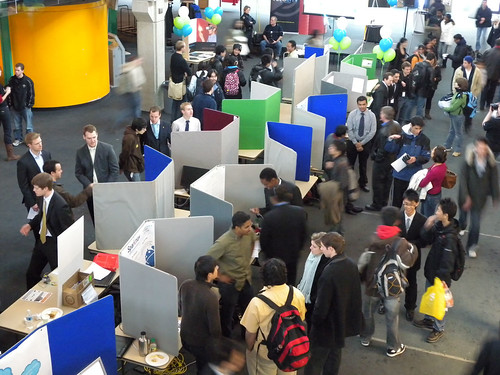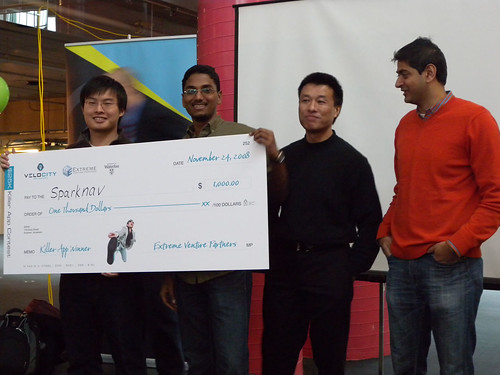Yesterday, I (along with David Crow and Barnaby Jeans, my colleagues at Microsoft Canada’s Developer and Platform Evangelism Team) went to the University of Waterloo to see the projects on display at the exhibition of a new initiative at the university called VeloCity.
VeloCity
VeloCity has been described as a “dorm for entrepreneurs”; I’ve also heard it referred to as a “dormcubator”. Taking a cue from successful businesses such as Dell, Facebook, Google, RIM and Yahoo!, which were started by students working in their dorm rooms, the VeloCity project aims to create an atmosphere that will encourage and enable Waterloo’s students to sharpen their technical and entrepreneurial skills, and perhaps even come up with “the next big thing”.
The university converted its Minota Hagey residence from a standard dorm into a place where its residents would have access to a boardroom, a mobile device lab, high-bandwidth wifi, large flatscreens, workstations, programmable lighting and other goodies that you might find at a high-tech company’s campus. Students in the VeloCity program live and work on their projects there; they also attend professional development workshops for entrepreneurs at the nearby Accelerator Centre.
The VeloCity projects are currently treated as extracurricular activity – they’re done in addition to their regular courseload. Adding to the challenge is the short timeline: they’ve only been working on their projects since the start of the school year in September.
Why wasn’t something like this around when I was in university?
The Exhibition
Yesterday’s exhibition was the VeloCity students’ first chance to show off their projects in their current state. Each project team set up a booth science-fair style in the foyer of Waterloo’s Davis Centre and did presentations to attendees and passers-by; they also had to do a three-minute pitch presentation onstage.
Extreme Venture Partners were there to judge the projects. They would provide $1000 to fund the project they deemed most worthy.
The projects participating in the exhibition are listed below.
| Project | Description |
| Grocerus | A location-aware web application that helps users create grocery lists and find the best prices for items on that list in their area. |
| Gruup | A web application that lets its users do group purchases of items for volume discounts. |
| Sparknav | A mobile navigation application with a twist: it’s for finding your way around indoor or enclosed spaces, such as malls, airports, university campuses and amusement parks. |
| Emoshion | A mobile app that provides “location-based high-end fashion news”. |
| Find It Off Campus | A web application that helps University of Waterloo students find off-campus housing. |
| Szello Mobile | A consultancy that does mobile UI design and provides a mobile UI development kit. |
| Fading Hearts / Magical Aces | Two projects: Fading Hearts is an anime-style multimedia “choose your own adventure” story-game. Magical Aces is a 2-D vertical shooter arcade game (in the style of Raiden) with manga-inspired story elements. |
| Ufansi | A web application that connects charities with donors, keeps donors apprised of their charities’ activities and helps to lower charities’ administrative costs. |
| Giftah | A web application that creates a marketplace for retailers’ gift certificates and gift cards. |
| ClassAlbum | A web application for managing class schedules and finding vacant classrooms. |
| Comic Battle | A multiplayer Flash-based online fighting game. |
| My Story | An “online platform where authors can share their creativity”. Authors can publish their stories, add media elements such as background music or voice-overs, get constructive feedback from their readers and even collect money for their stories. |
| CashIn | A wallet with an electronic component that acts as a financial advisor, tracking your spending and warning your spending is threatening to break your budget. |
| inPulse | A watch interface that acts as a secondary display for your mobile phone, allowing you to see caller ID, email and SMS messages or your calendar without having to fish your phone from your pocket or its holster. |
| Threadband | A 2-D casual game for the iPhone. |
| Metacast | A web application that combs the internet for video, places them into category-specific channels which can be viewed in a TV-like fashion. |
Before announcing the winner, the judges told the audience who their top three picks were:
- inPulse
- Sparknav
- My Story
Of these three, they picked Sparknav.
VeloCity will be holding another exhibition in March. It will be interesting to see how far these project (and the people behind them) progress in the interim.
Suggestions and Observations
Startups vs. Lifestyle Businesses
There is a difference between a startup and what Austin Hill referred to as a “lifestyle business” at the recent Startup Empire conference.
A lifestyle business is a service or consultancy that addresses the needs of a small or localized market. What it doesn’t do is make a product nor does it change the market it’s in or define a new one. There’s nothing wrong with these businesses; they meet certain needs and give their owners some money, ranging from discretionary income to enough to support a pool of small employees. Some notable lifestyle businesses include small development shops like 37signals and Toronto’s own Unspace, popular money-making sites like the Dooce and I Can Has Cheezburger? and applications like 37signals’ BaseCamp, Remember the Milk, Delicious Library and Hampton Catlin’s iPedia. While they are entrepreneurial and even fun to run (I’ve done one), they’re not the sort of thing that investors are looking to fund.
A startup is an attempt to create a new product that often creates a new market, or changes or becomes a big player in its market. It involves the creation of a new technology or the use of existing technology in a particularly novel way to solve a problem, often for a large market, if not the entire world. Apple, Microsoft, Yahoo!, Google, eBay and – to cite a Canadian example –- RIM are particularly big examples of startups. They are the sort of venture that investors are looking to fund.
The line between startups and lifestyle businesses can be fuzzy. A lifestyle business can sometimes grow into something startup-like or even a true startup because it defines a new market or changes the one it’s in. Craigslist falls under this category. Flickr and Blogger are examples of startup-like companies that grew out of side projects and were later acquired. Facebook started off as a lifestyle business but turned into a startup.
I believe that while VeloCity is trying to encourage tech entrepreneurialism in general, what they’re really trying to do is encourage students to become startup entrepreneurs. I think that the VeloCity participants should be mindful of the difference between startups and lifestyle businesses and steer towards projects that are more startup-like in nature.
Look Beyond the Consumer Market
A lot of people come up with product ideas for the consumer market because they’re graspable: they’re easy to think up and easy to implement. There’s a world of problems beyond consumer applications, and sometimes even a small solution can make a big difference. Think of the big issues that are on people’s minds today: the economy, the environment and healthcare, for starters.
Beware of Living Off Advertising
Once again, I’ll take a quote from Austin Hill: Advertising is not a business model. A business model is something that answers the question “How can I get customers no one else will get?”
Perfect your pitches
Pitching is considered a “soft” skill, which is the sort of thing that techies tend to discount. Even businesspeople sometimes consider it unimportant: at the recent Startup Empire, VC Austin Hill said that he’s seen CEOs who couldn’t pitch their way out of a paper bag. This is a mistake: no matter how good or cool your technology is, no one will care unless you can tell a story about it, and tell it well.
In “The Valley”, pitches are so important that they agonize over them. Countless blog posts, articles and books have been written on the art of pitching, and there are regular workshops where they work on their pitches.
Half of what makes a pitch is its content; the other half is its delivery. Your pitch needs to cover what your product is, what kind of problems it solves and why it’s the basis of a viable business. You also have to be able to make your case in two to three minutes, with delivery that engages the audience. You need to practice your pitch to the point that you can do it in your sleep.
One key point to remember is the point of pitching is not to go over your product’s feature set, but about its market and the needs that it will fill. Remember, people don’t really buy drills, they buy holes.
The best pitch of the bunch was delivered by Eric of inPulse, who started with the problem he was trying to solve, presented his “smart watch” phone interface as a solution, and then explained why inPulse was viable as a technology and a business. He quickly explained what the current state of the project was, what his expecting timelines were, his technology partners and what the goal was. His delivery was good, and he had some memorable lines in his pitch, most notably “We want to be the industry leader of smart watches in 2010” and “If you have any question, send an email…directly to my watch!” (David Crow groaned at that line, but I liked it. More importantly, we’ll both remember it.)
Honourable mention for good pitch goes to Caleb, Dane and Eric from CashIn, who also had a good presentation style and structure.


7 replies on “VeloCity Project Exhibition”
My first reaction was “did you punch the guys with the Emo in their name”?
More seriously though – and I think this thing is a great idea – is what’s up with the business advice they’re getting. In particular, both Grocerus and Sparknav are trying to solve problems that retail business doesn’t want solved: how to find a locally better price and how not to be lost in a mall!
@David
I can’t speak for Grocerus, but I get the sense they are going to go forward whether retailers are on board or not.
As for Sparknav (which I can speak for), this is something we’ve talked a lot about. We realize some places are going to be more willing to cooperate than others, and will pursue opportunities accordingly.
Thanks for taking all those pictures! They look great.
I found your suggestions and observations to be helpful. It’s important to think outside of your project once in a while to get a broader, higher-level view. Sometimes we focus so much on the technicalities that we miss the entire point of a project – to start a viable, manageable business.
Paul – best of luck (really!).
Perhaps there’s tradeoff or some yet-unfound-feature these malls would like that would make it work for them? The classic “lost in the mall” place for me is the PATH in downtown Toronto, tho I realize this is a bit out of the way for you guys. It’s probably worth having a chat with them or your local mall…
Hey Joey, thanks for checking out the show!
It was a lot of fun practicing pitches and seeing what everyone else ended up with. Glad you came by to talk and check out Metacast!
(Also as a bit of a preview, we’re rolling out a text-based section in the near future, hope to see Global Nerdy there!)
[…] week StartupNorth and Joey DeVilla covered VeloCity’s Project Exhibition. Both expressed some disappointment with the projects the […]
I have been checking up on your blog for a while. This is a really good one. Keep it up. I look forward to your future posts.